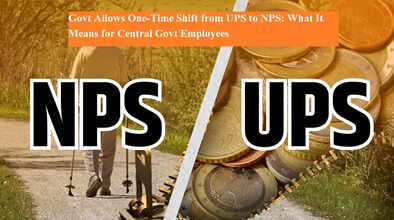Govt Allows One-Time Shift from UPS to NPS: What It Means for Central Govt Employees

In a major reform for retirement planning, the government has introduced a one-time option for central government employees to switch from the Unified Pension Scheme (UPS) to the National Pension System (NPS). According to a notification issued by the Ministry of Finance on Monday, employees will have the flexibility to make this transition—but only once, and within a specific timeframe.
Deadline and Conditions for Switching
As per the notification, central government employees can exercise the option to move from UPS to NPS up until 30 September 2025. However, this flexibility comes with certain restrictions:
-
The switch can be exercised only once in an employee’s career.
-
The request must be made at least one year before retirement or three months before voluntary retirement, whichever is earlier.
-
The same rules will apply in case of resignation, though some minor modifications may be introduced if required.
When Switching Is Not Allowed
While the option is a significant relief for many employees, it won’t be available under all circumstances. The notification clarifies that the switching facility will not apply in cases of:
-
Compulsory retirement imposed as a disciplinary penalty.
-
Dismissal or termination of service.
-
Pending or ongoing disciplinary proceedings.
This ensures that only eligible employees with clean service records can make use of the one-time option.
What Happens After the Switch?
Once an employee shifts from UPS to NPS, the PFRDA (Exits and Withdrawals) Regulations, 2015 will come into effect. This means:
-
The employee will no longer be entitled to the assured benefits promised under UPS.
-
Instead, retirement income will depend on market-linked returns generated under NPS.
-
A 4% differential contribution, calculated based on the default investment pattern, will be added to the NPS corpus at the time of withdrawal.
In simpler terms, while UPS guarantees fixed pension benefits, NPS provides flexibility and potentially higher returns, though with market risks.
Why This Matters
The government’s move aims to provide employees with greater flexibility in planning their retirement funds. Many financial experts believe that while UPS offers certainty, it lacks the growth potential of NPS. On the other hand, NPS—regulated by the Pension Fund Regulatory and Development Authority (PFRDA)—offers:
-
Multiple investment choices.
-
Professional fund management.
-
Tax benefits under Section 80C and 80CCD of the Income Tax Act.
-
The opportunity to create a larger retirement corpus over time.
By allowing this one-time shift, the government is giving employees the freedom to align their retirement planning with their long-term financial goals.
Expert Opinion
According to financial planners, the decision should not be made in haste. Employees nearing retirement may prefer the certainty of UPS, while younger employees could benefit from the compounding effect and higher growth potential of NPS.
Experts advise that employees should carefully evaluate:
-
Their retirement horizon.
-
Risk appetite.
-
Existing financial liabilities.
-
Future income needs.
Only after considering these factors should they decide whether shifting to NPS makes sense for their individual situation.
Final Takeaway
The one-time switch from UPS to NPS marks a significant policy change in India’s pension framework. While it opens up opportunities for higher retirement savings, it also comes with risks and the loss of guaranteed pension benefits.
Employees who wish to avail this option must act before 30 September 2025, keeping in mind that this choice is irreversible. Careful planning and financial consultation will be crucial before making the move.

